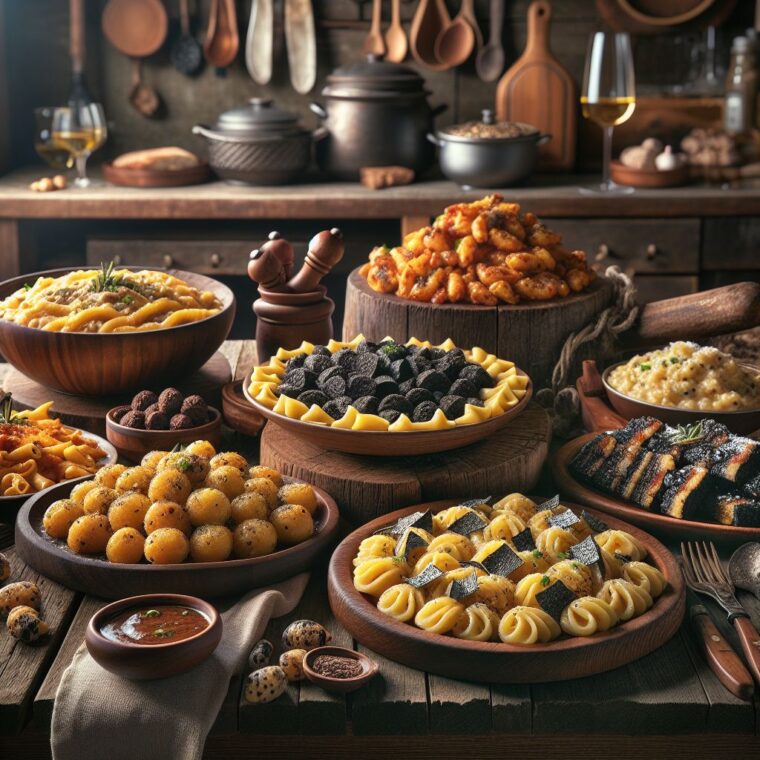- Rich Culinary Heritage: Croatian cuisine is a vibrant blend of Mediterranean, Central European, and Balkan influences shaped by centuries of cultural exchange. Each dish and preparation technique tells a unique story rooted in history and regional identities.
- Diverse Regional Flavors: The country’s culinary landscape ranges from coastal seafood specialties like Brodet and Buzara to inland hearty meals such as sarma and rustic stews. These dishes showcase the use of fresh, local ingredients and time-honored cooking methods that vary by region.
- Immersive Culinary Experiences: Exploring local markets, food tours, and family-run taverns provides authentic insights into Croatia’s gastronomic traditions. These experiences invite travelers to connect with the culture through seasonal produce, artisanal recipes, and communal dining practices.
KEY TAKEAWAYS
Introduction
Croatian cuisine must-try dishes take you on a flavorful journey shaped by Mediterranean charm and Central European depth. Croatia’s culinary identity is a mosaic crafted over centuries of trade, invasion, and cultural exchange. The result is a delectable blend of influences from Italy, Turkey, Hungary, and Austria—each region offering unique flavors rooted in history and seasonality.
This rich heritage lives through dishes that are both rustic and refined, from coastal seafood delicacies to hearty inland stews. Croatian cuisine reflects the soul of its local lifestyle—fresh ingredients, time-honored recipes, and a deep respect for regionality. Whether you’re exploring the sun-drenched Adriatic coast or the vineyard-covered hills of Slavonia, there’s a plate waiting to tell a story.
This guide explores must-try Croatian dishes that capture the essence of local cuisine. Discover what to eat, where to find it, and how each bite connects you to Croatia’s timeless gastronomic tale.
Understanding Traditional Croatian Food
Traditional Croatian food is best understood as a cuisine of regions—shaped by geography, climate, and centuries of cultural exchange. It reflects a deep culinary heritage defined by the fusion of Mediterranean, Central European, and Balkan influences. From Roman times to the Ottoman Empire and the Austro-Hungarian monarchy, each wave of history contributed ingredients, techniques, and spice profiles to Croatia’s diverse food culture.
Along the coast, especially in regions like Dalmatia and Istria, the local cuisine emphasizes Mediterranean staples—grilled fish, octopus salads, marinated anchovies, and the liberal use of olive oil and aromatic herbs like rosemary and bay leaf. These coastal dishes often mirror Italian and Greek flavors, with lighter preparations and seafood taking center stage.
Inland regions such as Slavonia, Lika, and Zagorje showcase heartier fare. Here, traditional Croatian dishes are built around slow-cooked meats, sausages, root vegetables, fermented cabbage, and dairy products. Hungarian paprika, black pepper, and garlic add depth and warmth, while cooking techniques such as stewing and baking maintain a rustic, comforting feel.
Essential ingredients across the country include locally produced olive oil, wild herbs, seasonal vegetables, freshwater and saltwater fish, cornmeal, fresh cheese, and foraged mushrooms. Markets brim with fresh produce, cured meats, and home-pressed oils—testaments to Croatia’s strong farm-to-table traditions.
Preserving authentic flavor relies on time-honored methods like brining, open hearth cooking, and wood-fired ovens. Geography not only dictates ingredients but shapes each region’s identity through food. From Adriatic coasts to Pannonian plains, traditional Croatian food captures a living history in every plate.
Top Must-Try Croatian Dishes
Croatia’s culinary treasures are deeply tied to its regional diversity, long history, and farming traditions. The following must-try Croatian dishes showcase the best of traditional Croatian food, revealing how geography and centuries of cultural influence have shaped a vibrant and flavorful local cuisine. Each bite tells a story passed down through generations.
Pašticada – Dalmatia’s Signature Slow-Cooked Beef
Pašticada is a jewel of Dalmatian culinary heritage. This centuries-old dish begins with beef marinated in red wine vinegar, garlic, cloves, and rosemary for at least 24 hours. The meat is then slowly braised in a rich sauce made from onions, prunes, red wine, and tomato paste. Sweet, sour, and deeply savory, Pašticada is traditionally served with homemade gnocchi or wide ribbon-like pasta.
Historically prepared for weddings, feast days, or saint celebrations, Pašticada reflects the Mediterranean influence on Croatian gastronomy. The slow-cooking technique imparts deep umami flavors, while the dried fruit adds a distinct sweetness. Originating in Split, its earliest versions may have Italian roots tracing back to Venetian stew traditions.
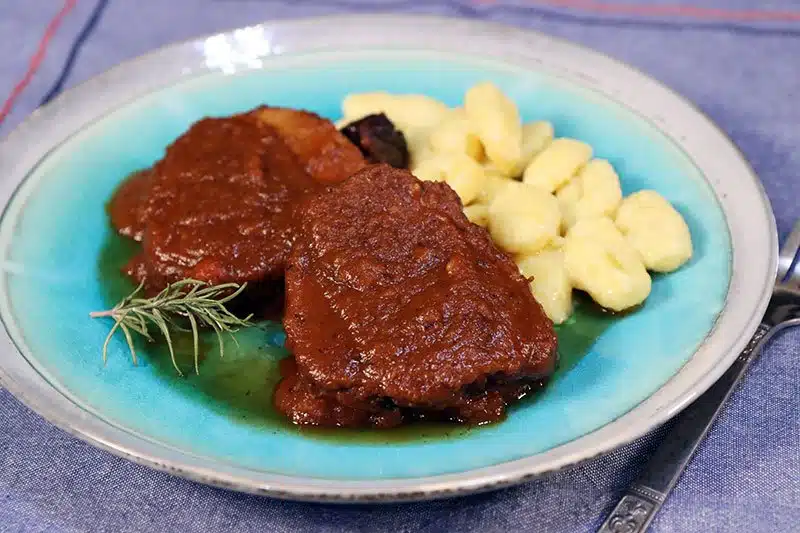
Čevapi – A Street Food Staple from the Balkan Grill
Čevapi, or ćevapčići, are small finger-length minced meat sausages without casings, grilled over open flames. They are made from a blend of beef, lamb, and pork (depending on the region), combined with garlic, salt, and sometimes baking soda to create a tender interior. Crispy on the outside and juicy inside, they are typically served nestled in lepinja (flatbread), with chopped raw onions, sour cream, and a generous scoop of ajvar – a roasted red pepper and eggplant relish.
This dish is a beloved everyday meal across Croatia, especially in the inland regions like Slavonia and Zagreb. Born of Ottoman influences, Čevapi has become a symbol of Balkan street food. On warm evenings, the scent of grilled meat fills Croatian neighborhoods, as locals gather around open grills.
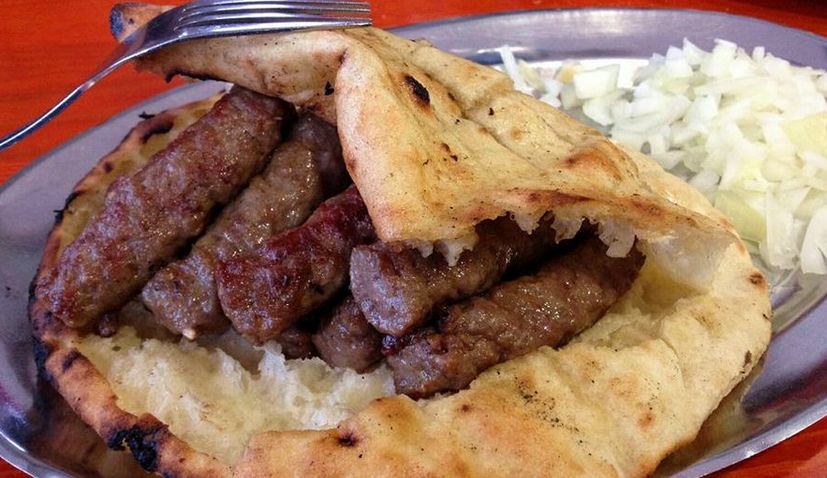
Peka – Timeless Hearth-Cooked Perfection
Peka is less a dish, and more a traditional Croatian cooking method that transforms whatever it touches. Cooked under a heavy, bell-shaped iron lid (also called “čripnja”) buried in hot embers, it slow-roasts food to create sublime tenderness and flavor.
The most common ingredients include lamb, veal, or octopus, layered with potatoes, carrots, onions, garlic, and rosemary—all drizzled with olive oil and white wine. Left to stew in its own juices and steam, the end result is a melt-in-your-mouth harmony of flavors.
Peka is often reserved for special occasions and family gatherings. It’s deeply rooted in Dalmatian and hinterland villages, reflecting a traditional Croatian food culture built on patience, wood fires, and communal eating.
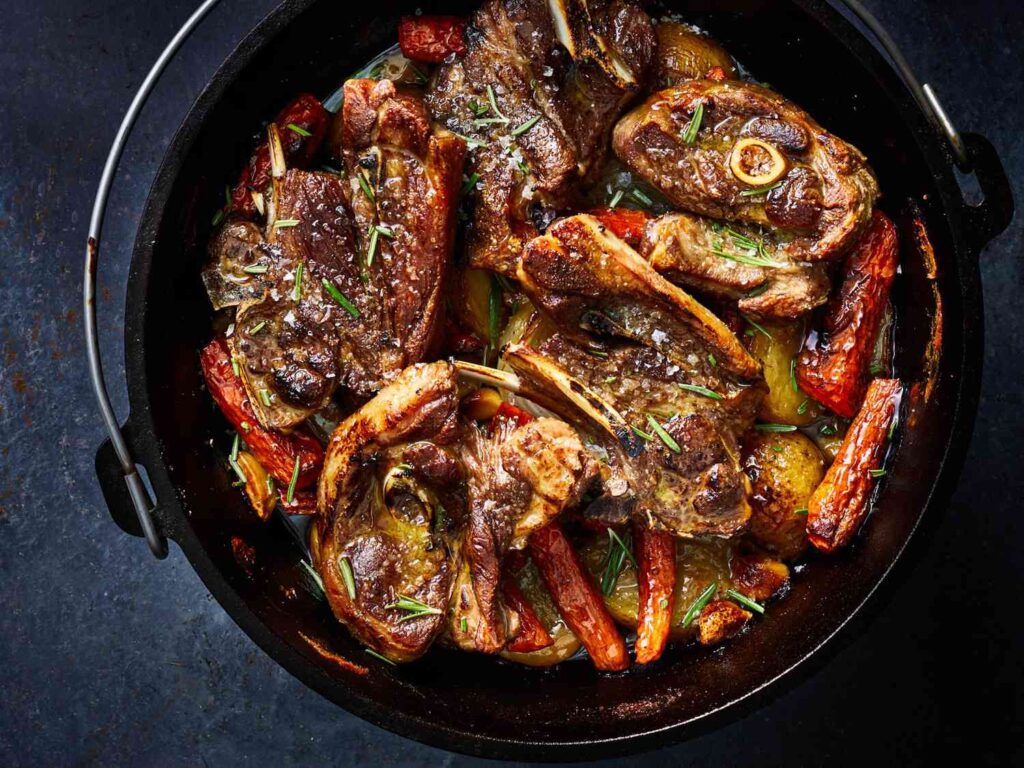
Black Truffles – Istria’s Forest Gold
Northwestern Croatia, especially the Motovun forest in Istria, is famed for one of the world’s most prized culinary ingredients—black and white truffles. Istrian truffles appear seasonally and are found with the aid of trained dogs or pigs. Local truffle hunting tours educate visitors about these fungi and their intricate wilderness ecosystem.
Croatian black truffles flavor many beloved regional dishes. Fuži s tartufima features handmade thin pasta with cream-based sauces infused with black truffle shavings. Truffle risotto, scrambled eggs with truffles (fritaja), and even truffle cheeses are popular Istrian delicacies. Due to its unique terroir and climate, Istria offers one of the richest truffle foraging regions outside Italy.
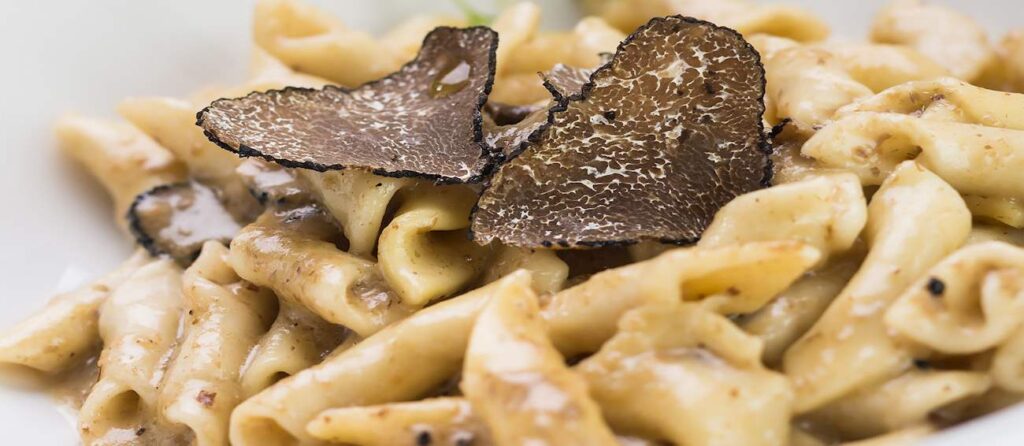
Buzara – Coastal Croatia’s Briny Simplicity
Buzara is not a dish but a rustic Adriatic style of cooking shellfish that emphasizes simplicity and freshness. The white version combines mussels, shrimp, or clams with garlic, parsley, olive oil, and white wine. A red version includes tomato and breadcrumbs, adding deeper sweetness.
Restaurants along the Dalmatian coast serve Buzara in heaping bowls, often accompanied by crusty bread for sopping up the aromatic broth. The technique showcases the Adriatic’s seafood abundance and Croatia’s reliance on fresh, unadulterated ingredients. The word “buzara” can be translated loosely as “stew,” though the method is more akin to poaching than true stewing.

Sarma – Hearty Winter Comfort
Sarma is a warming, hearty dish popular in the inland parts of Croatia, particularly during winter and around holidays. It consists of cabbage leaves fermented in brine, rolled around a mixture of minced pork or beef, rice, onions, and spices like paprika and pepper. The rolls are slow-cooked with smoked ribs or sausage in a tomato base layered with sauerkraut.
The flavor is tangy and rich, with a distinctive sourness from the fermented cabbage, balanced by the smoky, meaty aroma. Sarma has Balkan, Turkish, and Austro-Hungarian roots, and it symbolizes the culinary fusion embedded in Croatian food culture. It’s most comforting when paired with potatoes or crusty bread to mop up the sauce.
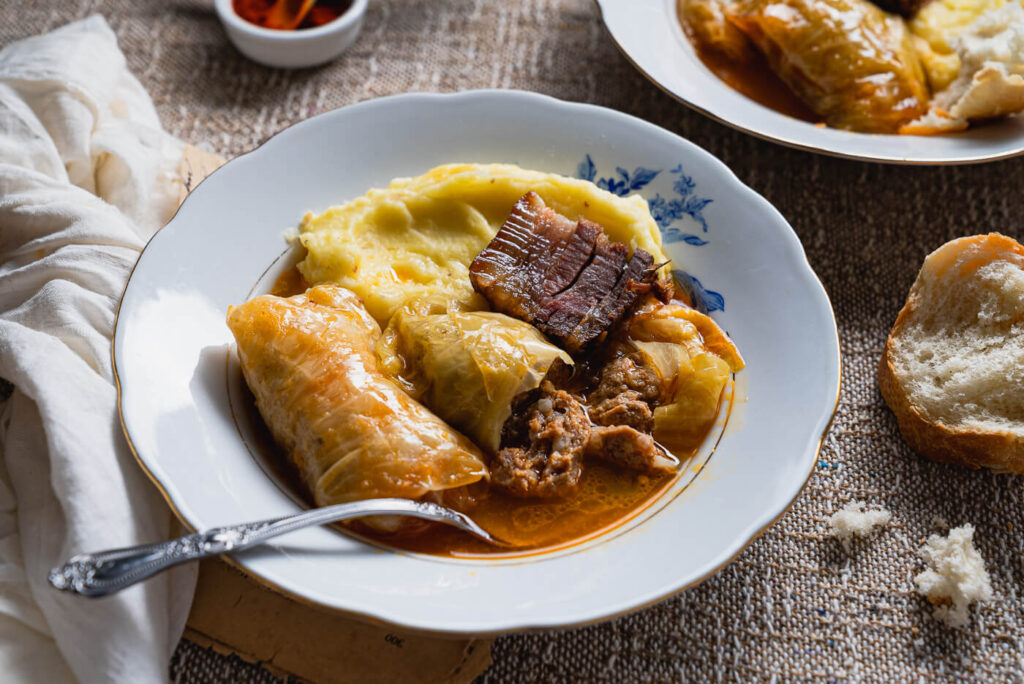
Soparnik – A Culinary Window into History
Soparnik is an ancient Dalmatian pie from the Poljica region near Omiš, believed to predate even the Ottoman Empire. It’s a thin, double-layered pastry filled with finely chopped Swiss chard (blitva), garlic, parsley, and olive oil. Once sealed, it’s baked directly on a stone slab in a wood-fired oven, then brushed with more garlic-infused olive oil.
This humble flatbread once served as a fasting dish for peasants. Today, it’s a protected intangible cultural heritage item under Croatian law. Soparnik’s crisp, flaky crust and herbaceous filling offer an earthy, rustic flavor—representing traditional Croatian food at its most authentic.
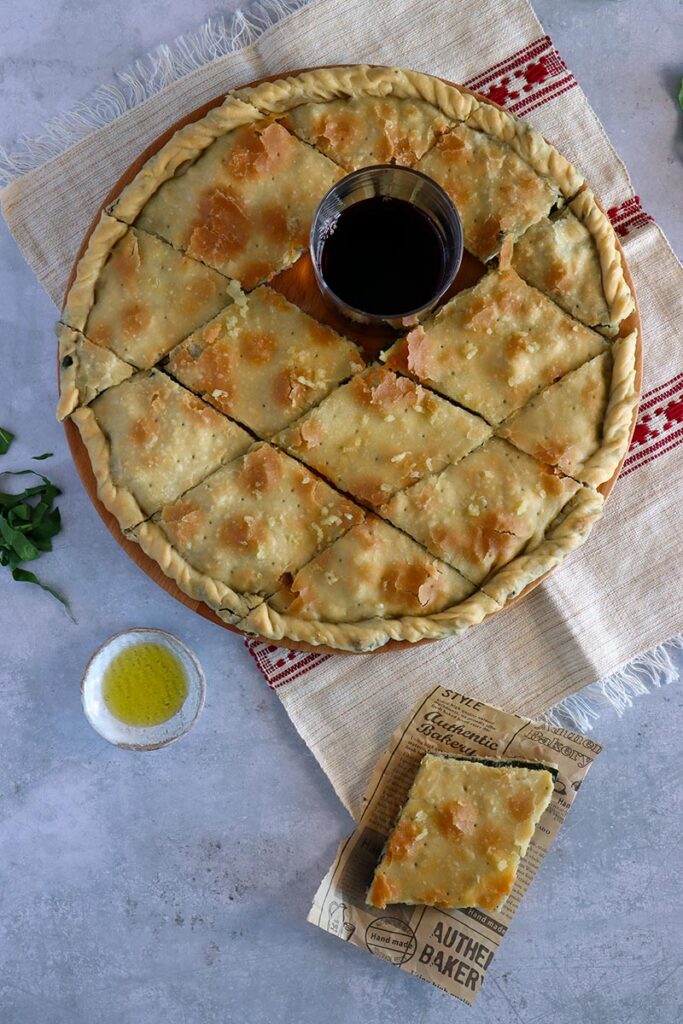
Fuži with Truffles – Istria’s Signature Pasta Dish
Fuži is handmade pasta shaped by rolling small diamond-shaped dough pieces around a wooden spoon handle. When served with cream-based black truffle sauce, it becomes one of the most luxurious dishes of Croatian gastronomy.
The pasta’s soft texture soaks up the earthy, pungent truffle aroma, balanced by rich dairy notes. Often finished with grated cheese and olive oil, Fuži with Truffles embodies Istria’s forest and farm culture. It’s a must-try for travelers journeying through the peninsula’s medieval hilltop towns.
Brodet – Fisherman’s Classic on the Adriatic
Brodet (also known as brudet or brujet) is a slow-cooked fish stew originating from Dalmatia and Kvarner. Using whatever the day’s catch provides—typically grouper, scorpionfish, or eel—it’s simmered with onions, tomatoes, garlic, olive oil, vinegar, and wine.
Often served with creamy polenta or homemade bread, Brodet represents rustic, seafaring cooking. It dates back to centuries of fishermen who cooked their least marketable fish aboard boats. Each Croatian coastal town has its own twist, and family recipes are passed down like heirlooms. Sweet-acidic, with tender morsels of fish, Brodet echoes the Adriatic sea in every bite.
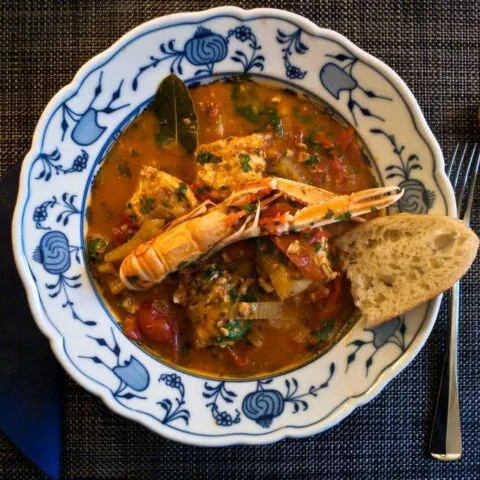
Štrukli – A Delicate Pastry from Hrvatsko Zagorje
Štrukli, hailing from the region of Hrvatsko Zagorje near Zagreb, is a beloved pastry dish filled with cottage cheese, sour cream, and eggs. The dough is rolled thin, stuffed, then boiled or baked. Baked versions are topped with cream, creating a rich, golden crust.
Štrukli can be sweet or savory and are enjoyed year-round, often during festive occasions and family lunches. Light, creamy, and satisfying, Štrukli is also served in many luxury restaurants and even Croatian embassies abroad as a symbol of national pride.
These must-try Croatian dishes reveal the rich variety of traditional Croatian food—each recipe grounded in the land or sea it comes from, with a story deeply embedded in local cuisine.
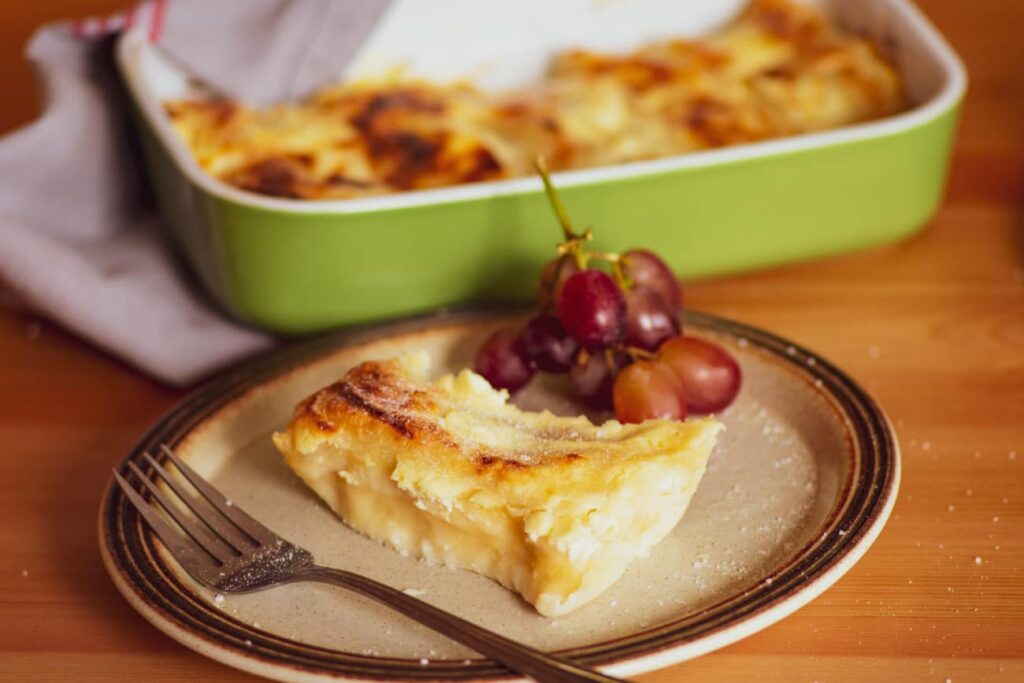
Exploring Local Cuisine Beyond the Basics
Croatia’s culinary map is rich with hidden gems that reflect centuries of regional heritage. While many visitors savor iconic dishes, the heart of traditional Croatian food can be found in humble, often overlooked recipes and seasonal specialties.
One such dish is Grah, a hearty bean stew beloved across inland villages. Made with smoked meats like kobasica or cured pork, paprika, onions, and bay leaf, it’s a winter staple with deep Slavic roots. In coastal Dalmatia, Brudet (or Brodet) offers a rustic fisherman’s stew combining assorted Adriatic fish, tomatoes, garlic, and local wine, typically served with cornmeal polenta to soak up the sauce.
For seafood lovers, Škampi na buzaru is a must — Adriatic scampi slow-cooked with garlic, parsley, white wine, and olive oil. Unlike other preparations, Buzara enhances the natural taste with minimal ingredients, reflecting a time-honored coastal style.
Spring unlocks the wild asparagus season, with locals foraging fresh shoots to stir into omelets, risottos, or pasta. Autumn welcomes game season, with venison and boar featured in rich stews spiced with juniper and served alongside mlinci or root vegetables.
Venture into konobas — rustic taverns where grandmothers still cook — or engage with agrotourism sites offering farm-to-fork experiences. These spots capture the soul of local cuisine and offer deeper cultural connections beyond restaurant menus.
Food Tours in Croatia
Croatia’s diverse regions offer guided food tours that reveal the depth of its regional gastronomy. From bustling cities to rural Istrian hills, these immersive journeys connect travelers directly with local cuisine and time-honored culinary traditions.
In Zagreb, walking food tours often begin at Dolac Market—one of the most iconic open-air markets in the country. With origins dating back to 1930, it provides a colorful introduction to daily Croatian food culture. Guides lead visitors through stalls overflowing with cured meats, fresh vegetables, and artisanal cheeses, explaining ingredients used in traditional dishes like sarma (stuffed cabbage rolls) and krvavice (blood sausages).
Coastal cities like Split and Dubrovnik offer seafood-focused excursions that dive into Dalmatian coastal cuisine. These tours introduce guests to recipes like brodet (fish stew), grilled sardines with chard, and crni rižot, the rich squid ink risotto beloved by locals. Often paired with local wines such as Pošip and Plavac Mali, tastings take place in seaside konobas or hidden courtyards of family taverns.
In Istria, full-day culinary tours explore truffle forests near Motovun and Buzet. With local truffle hunters and trained dogs, guests forage for black and white truffles, followed by tasting sessions that include fuži pasta with truffle cream. Wine and olive oil tastings reveal the region’s terroir—structured Malvasia and robust extra virgin oils are local staples.
Cooking classes, particularly in Dalmatia, give travelers the chance to make must-try Croatian dishes like pašticada—beef stewed in wine, prunes, and rosemary. These hands-on sessions often take place in rural households or agrotourism kitchens, deepening appreciation for local methods.
Reputable providers often offer customizable food tours in Croatia, adapting menus for dietary needs. Booking in advance is recommended, especially during peak travel months.
Learn about cultural tours in Croatia.
The Role of Local Markets and Restaurants
The soul of traditional Croatian food is most vividly experienced at local markets and family-run taverns. Markets like Dolac in Zagreb, known as the “Belly of Zagreb,” offer daily access to seasonal vegetables, Adriatic seafood, foraged mushrooms, wild asparagus, and hand-crafted cheeses. Open since the 1930s, Dolac is more than a marketplace—it’s a living tapestry of Croatia’s agricultural traditions and local cuisine heritage.
Visiting early in the morning yields the freshest picks, from lavender honey from Hvar to Pag island’s award-winning sheep cheese. Artisanal vendors often pass recipes and techniques down generations, preserving authentic flavors and regional specialties.
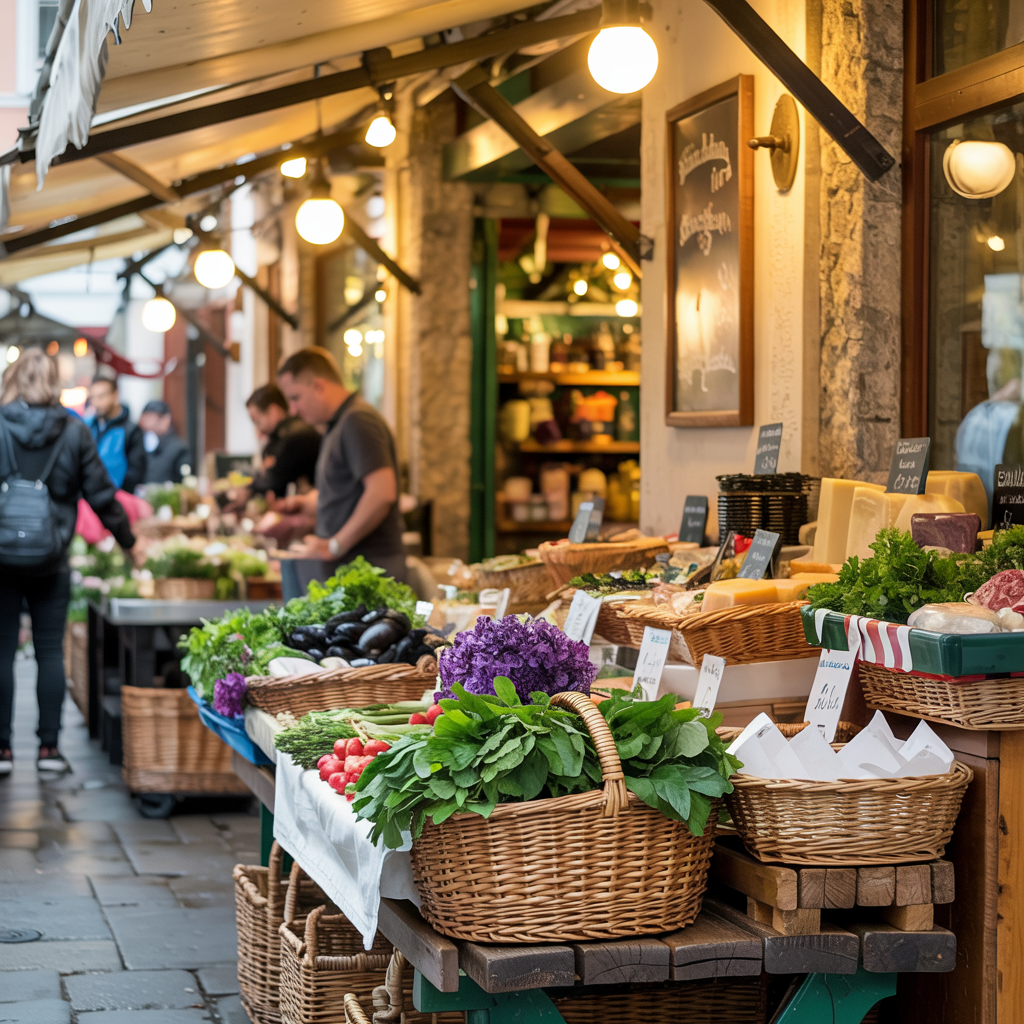
Across the country, dining in locally respected konobas and bistros further connects travelers with native gastronomy. Konoba Mate on Korčula Island serves rustic dishes like makaruni pasta with slow-cooked lamb, made using ingredients from their own garden. In Šibenik, Pelegrini blends innovation with history, creating modern interpretations of Dalmatian seafood using traditional techniques and ingredients like fig reductions and cuttlefish ink.
To discover genuine local flavor, explore neighborhoods away from tourist hotspots. Asking grocers or market vendors for dining suggestions often leads to incredible finds. Supporting these small-scale enterprises helps keep the heart of Croatian culinary culture alive in every bite.
Pairing Croatian Dishes with Local Beverages
Croatian cuisine is best enjoyed alongside its remarkable selection of traditional drinks. Croatia’s winemaking history dates back over 2,500 years, and today, its regional wines are gaining global recognition. Istria, in the north, is celebrated for white varietals like Malvazija Istarska—dry, aromatic, and a perfect match for shellfish or grilled sea bass prepared “na gradele.” Heading south to Pelješac Peninsula, one finds bold red wines like Plavac Mali, the autochthonous grape that thrives in sun-drenched, rocky soils. Plavac Mali’s full body and rich tannins make it an excellent pairing for hearty Dalmatian dishes, especially pašticada, a slow-cooked beef stew in sweet vinegar and prunes.
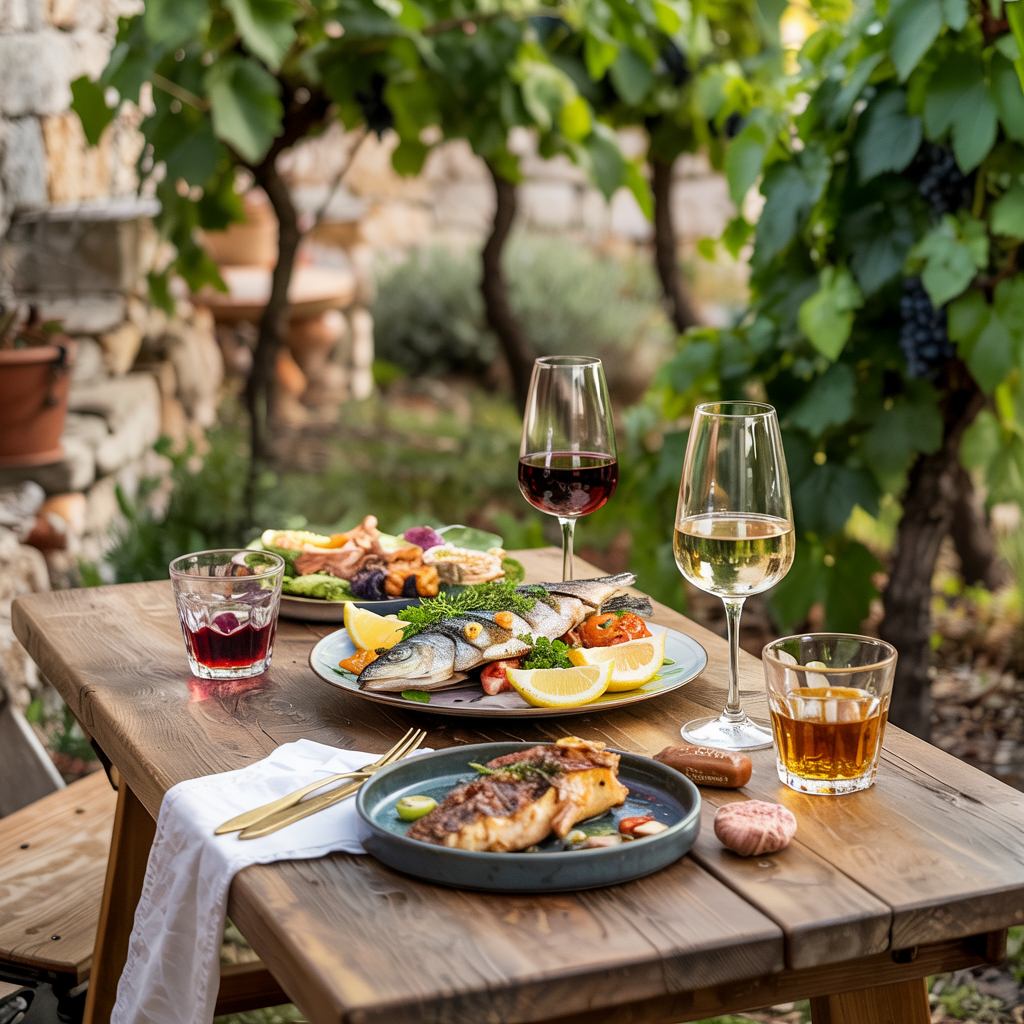
Beyond wine, Croatian cuisine incorporates traditional spirits like rakija, distilled from fruits or herbs. Loza (grape-based) pairs well with cured meats, while the fig-infused smokvenjak rakija complements desserts or cheese platters. Don’t miss prošek—a Dalmatian dessert wine made from partially dried grapes. Its honeyed sweetness enhances flavors in walnut-stuffed pancakes (palačinke) or rožata, the Adriatic’s crème caramel cousin.
Beverage pairings are more than taste—they embody Croatian hospitality and regional pride. Meals linger over glasses of local wine, reinforcing the social, leisurely essence of the local cuisine. Sampling these drinks offers a richer, deeper understanding of Croatia’s culinary soul.
Conclusion
From coastal Delmatian seafood to hearty inland stews, every dish reveals a piece of Croatia’s diverse identity. We explored iconic Croatian cuisine must-try dishes like peka, black risotto, and Istrian truffle pasta—each rooted in centuries-old local traditions. These specialties are more than meals; they reflect historical influences from Roman, Venetian, Ottoman, and Austro-Hungarian eras. Local cuisine thrives on fresh, often seasonal ingredients—olive oil from Dalmatia, paprika in Slavonia, and Adriatic anchovies—showing how geography shapes the table.
By sampling these regional flavors, travelers gain insight into Croatia’s coastal rhythms and village customs. Culinary exploration unlocks a deeper understanding of the nation’s soul—from olive groves in Istria to vineyards in Pelješac. So, let these dishes inspire your trip. Taste, learn, and fully surrender to the aromas and stories of the Croatian table. We welcome you to share your food discoveries and add your favorite local bites to this rich conversation.
Explore the yacht charter Croatia options.
Additional Resources
To continue your discovery of authentic Croatian cuisine, book culinary walking tours through verified platforms like the Croatian National Tourist Board. For traditional dishes like peka or pašticada, explore top-rated eateries via Time Out Croatia. For official recipes of iconic local cuisine, the Croatia Week recipe archive offers step-by-step guides. Serious food lovers can deepen their knowledge with books like “Croatian Cuisine” by Aleksandra Čeč, or browse the Wikipedia page on Croatian cuisine for cultural context and regional variations.
| Category | Details |
| Cultural Influences | Fusion of Mediterranean, Central European, Balkan, Ottoman, Venetian, and Austro-Hungarian flavors shaping centuries-old recipes. |
| Key Regions | – Coastal areas: Dalmatia, Istria – Inland regions: Slavonia, Lika, Zagorje |
| Must-Try Dishes | – Pašticada (slow-cooked beef with prunes and red wine) – Čevapi (grilled minced meat sausages) – Peka (hearth-cooked lamb, veal, or octopus) – Istrian Fuži with Truffles – Black Truffles delicacies – Buzara (shellfish poached in garlic and wine) – Sarma (stuffed fermented cabbage rolls) – Soparnik (Dalmatian chard-filled pie) – Brodet (fish stew) – Štrukli (cheese pastry) |
| Essential Ingredients | Local olive oil, wild herbs, seasonal vegetables, fresh seafood, slow-cooked meats, dairy products, and unique spices like Hungarian paprika. |
| Cooking Techniques | Slow braising, wood-fired oven cooking, open hearth methods, brining, and traditional stewing methods under “peka.” |
| Culinary Experiences | – Food tours in Zagreb (e.g., Dolac Market), Split, Dubrovnik, and Istria – Cooking classes emphasizing traditional dishes like pašticada and peka – Agrotourism experiences for farm-to-table dining |
| Beverage Pairings | – Croatian wines: Malvazija Istarska (white), Plavac Mali (red) – Traditional spirits: Rakija (loza and fruit-infused varieties), Prošek dessert wine |
| Seasonal Highlights | – Spring: Wild asparagus and fresh produce – Autumn: Game stews and venison dishes – Winter: Hearty stews like sarma and bean-based grah |
| Additional Resources | Explore further via the Croatian National Tourist Board, Time Out Croatia restaurant guides, and the Croatia Week recipe archive for authentic recipes. |
FAQs
Croatian cuisine boasts a variety of must-try dishes such as Pašticada, a slow-cooked beef dish from Dalmatia; Čevapi, Balkan-style grilled sausages; and Peka, a traditional hearth-cooked meal. Each dish reflects local influences and traditional cooking methods.
Sarma, which consists of cabbage leaves wrapped around a mixture of meat and rice, is a popular winter dish in Croatia. It’s often served with sauerkraut and spices, reflecting deep-rooted Balkan and Central European influences.
Istrian cuisine is renowned for its use of black and white truffles, especially in dishes like Fuži with truffle sauce. The region offers rich wines like Malvasia, and the cuisine often highlights seasonal ingredients and traditional recipes.
Peka involves cooking meat and vegetables under a bell-shaped lid buried in hot embers, allowing flavors to meld slowly. It’s a Dalmatian culinary tradition that embodies patience and communal value, often reserved for special occasions.
Čevapi are finger-length grilled sausages without casings, commonly found in inland regions like Zagreb and Slavonia. Inspired by Ottoman food traditions, they are a quintessential street food staple in Croatia.
Local markets like Zagreb’s Dolac Market are crucial for experiencing authentic Croatian cuisine. They offer fresh, seasonal ingredients, such as seafood, olive oil, and truffles, which are staples in many Croatian dishes, showcasing the country’s rich farm-to-table heritage.
Fuži, a handmade pasta paired with a black truffle cream sauce, is a hallmark of Istrian cuisine. The dish highlights the region’s truffle-rich forests and its longstanding culinary traditions, making it a luxurious representative of local gastronomy.

